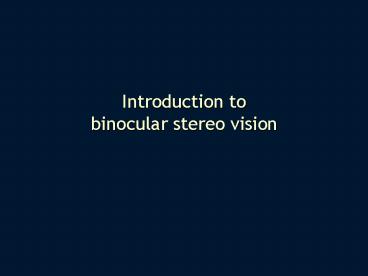Introduction to binocular stereo vision - PowerPoint PPT Presentation
1 / 40
Title:
Introduction to binocular stereo vision
Description:
... of getting depth (3-D) information about a scene from two 2 ... Using neighbourhood windows. Introduction to binocular stereo vision. 32. Area-based matching ... – PowerPoint PPT presentation
Number of Views:913
Avg rating:3.0/5.0
Title: Introduction to binocular stereo vision
1
Introduction to binocular stereo vision
2
What is binocular stereo vision?
- A way of getting depth (3-D) information about a
scene from two 2-D views (images) of the scene
3
What is binocular stereo vision?
- A way of getting depth (3-D) information about a
scene from two 2-D views (images) of the scene - Used by humans and animals
4
What is binocular stereo vision?
- A way of getting depth (3-D) information about a
scene from two 2-D views (images) of the scene - Used by humans and animals
- Computational stereo vision
- Programming machines to do stereo vision
- Studied extensively in the past 25 years
- Difficult still being researched
5
Purpose of this lecture
- An introduction to
- Basic principle of stereo vision
- Computational stereo analysis
- How does it work?
- What is required?
- Where are the difficulties?
6
Purpose of this lecture
- An introduction to
- Basic principle of stereo vision
- Computational stereo analysis
- How does it work?
- What is required?
- Where are the difficulties?
7
Fundamentals of stereo vision
- A camera model
- Models how 3-D scene points are transformed into
2-D image points - The pinhole camera a simple linear model for
perspective projection
8
Fundamentals of stereo vision
- The goal of stereo analysis
- The inverse process From 2-D image coordinates
to 3-D scene coordinates - Requires images from at least two views
9
Fundamentals of stereo vision
- 3-D reconstruction
10
Fundamentals of stereo vision
- 3-D reconstruction
11
Fundamentals of stereo vision
- 3-D reconstruction
12
Fundamentals of stereo vision
- 3-D reconstruction
13
Fundamentals of stereo vision
- 3-D reconstruction
14
Fundamentals of stereo vision
- 3-D reconstruction
15
Fundamentals of stereo vision
- 3-D reconstruction
16
Fundamentals of stereo vision
- 3-D reconstruction
17
Prerequisites
- Camera model parameters must be known
- External parameters
- Positions, orientations
- Internal parameters
- Focal length, image center, distortion, etc..
18
Prerequisites
- Camera calibration
19
Two subproblems
- Matching
- Finding corresponding elements in the two images
- Reconstruction
- Establishing 3-D coordinates from the 2-D image
correspondences found during matching
20
Two subproblems
- Matching (hardest)
- Finding corresponding elements in the two images
- Reconstruction
- Establishing 3-D coordinates from the 2-D image
correspondences found during matching
21
The matching problem
- Which image entities should be matched?
- Two main approaches
- Pixel/area-based (lower-level)
- Feature-based (higher-level)
22
Matching challenges
- Scene elements do not always look the same in the
two images - Camera-related problems
- Image noise, differing gain, contrast, etc..
- Viewpoint-related problems
- Perspective distortions
- Occlusions
- Specular reflections
23
Choice of camera setup
- Baseline
- distance between cameras (focal points)
- Trade-off
- Small baseline Matching easier
- Large baseline Depth precision better
24
Matching clues
- Correspondance search is a 1-D problem
- Matching point must lie on a line
25
Matching clues
- Epipolar geometry
26
Matching clues
- Epipolar geometry
27
Rectification
- Simplifies the correspondance search
- Makes all epipolar lines parallel and coincident
- Corresponds to parallel camera configuration
28
Goal disparity map
- Disparity
- The horizontal displacement between corresponding
points - Closely related to scene depth
29
More matching heuristics
- Always valid
- (Epipolar line)
- Uniqueness
- Minimum/maximum disparity
- Sometimes valid
- Ordering
- Local continuity (smoothness)
30
Area-based matching
- Finding pixel-to-pixel correspondences
- For each pixel in the left image, search for the
most similar pixel in the right image
31
Area-based matching
- Finding pixel-to-pixel correspondences
- For each pixel in the left image, search for the
most similar pixel in the right image - Using neighbourhood windows
32
Area-based matching
- Similarity measures for two windows
- SAD (sum of absolute differences)
- SSD (sum of squared differences)
- CC (cross-correlation)
33
Feature-based matching
- Matching features
- Edge points
- lines
- corners
- Sparse reconstruction sets
- Best if scene type is known a priori
34
Area-based matching
- Choice of window size
- Factors to considers
- Ambiguity
- Noise sensitivity
- Sensitivity towards viewpoint-related distortions
- Expected object sizes
- Frequency of depth jumps
35
Area-based matching
- Variable window position
- Better matching at depth jumps (disparity edges)
36
Three or more viewpoints
- More matching information
- Additional epipolar constraints
- More confident matches
37
Summary
- Stereo vision
- A method for 3-D analysis of a scene using images
from two or more viewpoints - Two subproblems
- Matching
- Reconstruction
- Most difficult part Matching
- Two main approaches
- Area based Dense reconstruction
- Feature based Sparse reconstruction
38
Modelling stereo quantification error
39
Stereo error quantification
The variance
Numerical solution
40
Error analytical vs. Numerical solution































